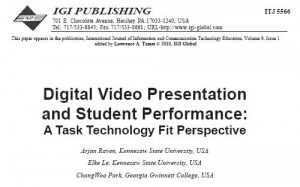Citation: Raven, A., Le, E., and Park, C. (2010). Digital video presentation and student performance: A Task technology fit perspective. International Journal of Information and Communication Technology Education, 6 (1), 17-29. doi: 10.4018/jicte.2010091102

Main Points:
– A paper that reported the results of a confirmatory study about information systems (IS) research of a task technology fit (TTF) model. It applied the three dimensions of fit: task match, ease of use, and ease of learning, in the context of digital video tools for oral presentation in a classroom environment.
– Students completed a digital video (DV) presentation that acted as a substitute for an in-class oral presentation. An existing survey instrument was adapted, and administered to the students to examine the impact on presentation skill and fit to task.
– Results confirm the adaptation of the TTF model and show significant relationships between variables. The model can be used in other task/technology combinations.
– Findings suggest that when there is a significant fit between digital video tools (technology) and improvement of oral presentation skills (task), student performance also improves.
– Digital video can be a useful alternative to in-class presentation when the goal is to improve presentation skill.
Analysis:
This article does a very good job in describing the pedagogy of the IS research, which is concerned with more thoroughly understanding the relationship between information systems and user performance, which in the development of the TTF model. This study looks at an important aspect and practical use of digital technology to enhance learning and prepare undergraduates for the real world requirements of presentation knowledge and experience. The students in the sample received preparatory instruction, readings, discussions, and video file analysis, assigned to small teams, completed a digital video presentation, and after presentations completed surveys via WebCT Vista. They clearly explain their use of the partial least squares analysis, which is an extension of the multiple linear regression model, their measurement model, and the research questions they applied. The authors found that performance in the class does not only depend on how bright the student is, or how hard they work. If the technology and task are not carefully matched then students won’t learn. They believe their results show that digital video can be a useful alternative to in-class presentation when the goal is to improve presentation skills. The authors close the paper discussing the limitations of the study and the need for future research.

No Comments so far ↓
There are no comments yet...Kick things off by filling out the form below.